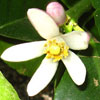You'll see a variation in the number of seeds in each fruit on the same tree (at the same time) because citrus (for the very most part), do not need to be cross pollinated to produce fruit. They are parthencarpic - producing fruit without the need of cross pollentation. With the notable exception of some tangelos (Minneola/Honeybelle & Orlando), as well as Clementine & Fairchild mandarins. Also, some citrus flowers have poorly developed stamens and ovaries or do not produce much pollen or sterile pollen, so even if cross-pollinated, the pollen never makes it down to the ovary to form a seed. So, depending upon how busy the bees are on a tree, and depending upon that cultivar's flower reproductive parts, you'll see a wide variance with seed formation on certain cultivars, from one fruit being pretty seedy, to another fruit with no seeds. The trees that produce either seedless or nearly seedless fruit either have little to no pollen, or very poorly developed ovaries and tubules, so seed formation just rarely if ever happens (i.e., Seedless Kishu, Dekopon/Shirnaui mandarins). Other citrus are sort of "in between", and then you have a few citrus, that if there are cross pollinators available, will be very, very seedy, and uniformly seedy if you've got a busy bee/pollinator population (like I do, example being the W. Murcott Afourer mandarin).
Clear as mud??








